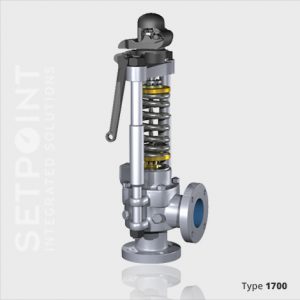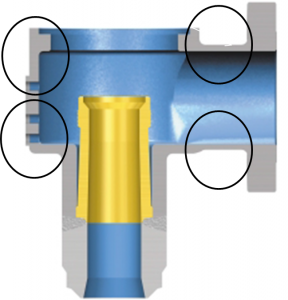Is Your Section 1 Boiler Safety Valve Body Wall Eroding?

Is your Section 1 Boiler Safety Valve Body Wall Eroding? With many of these valves being original installation, making it is possible that 75% of all current Boiler valves were installed in the 1960’s*, the answer is probably yes.
Body wall deterioration can occur over time in any process, and is an often overlooked factor in the review and repair of a safety valve population. Other issues related to the body wall thickness factor are that the availability of old design parts is declining, and the nozzle height of older models is different than what is available today.
The National Board Inspection Code does not address the wall thickness of Safety Valves as a component of the VR Program. This could lead to failure if the wall thickness is not sufficient for the pressure / reaction force that is acting on it. If this feature is never checked in accordance with a standard, it could prove to be the feature that causes a failure.
Additionally, inspecting the body wall thickness of your safety valve population helps to minimize the risk associated with the current long lead time for new Safety Valves. Anticipating outages before they can occur helps to position end users to be their most competitive.
So how do you know when the wall thickness has become to thin?
ASME B16.34, Table 3B showcases the ASME Valve Body Minimum Wall Thickness* calculations per diameter and pressure class. Utilizing this table will help better inform the end user of the state of their valve body wall, leading to prevention of a failure.
 The circles identify areas in which body wall inspection may not be a requirement of the Valve’s repair process. The areas are the ones that Setpoint IS recommends reviewing to check if they adhere to ASME B16.34-2013 Table 3B.
The circles identify areas in which body wall inspection may not be a requirement of the Valve’s repair process. The areas are the ones that Setpoint IS recommends reviewing to check if they adhere to ASME B16.34-2013 Table 3B.
As the experts in the service, maintenance, and repair of Safety Valves, Setpoint Integrated Solutions stands by as a trusted partner to inspect your safety valve population. We look forward to helping you identify issues before they occur while improving safety and mitigating costly downtime.
_________________________________________________
*Citation of the age of valves still in service found in “America’s Aging Generation Fleet” – Neil Powell, analyst for SNL Energy, as found here.
*Citation of ASME 6.1.1 of B16.34-2013 regarding Wall Thickness, which states: “For inspection purposes the wall thickness of valve bodies at the time of manufacture, except as indicated in paras. 6.1.3 through 6.1.7, 6.2, and 6.7, shall be no less than the minimum values “tm” either as shown in table 3A or table 3B or calculated using the equation shown in Mandatory Appendix VI (which yield essentially the same result). Linear interpolation may be used for wall thickness values intermediate to those listed or calculated. See Nonmandatory appendix B, section B-5 for an explanation of the interpolation procedure. The minimum thickness requirement for the body wall is applicable only as measured from internal walled surfaces. Minimum wall thickness shall not include liners, linings, or cartridges.
*Citation: This work was produced in collaboration with Bart Collins, Vice President, Operations, Precision Pump & Valve Service

